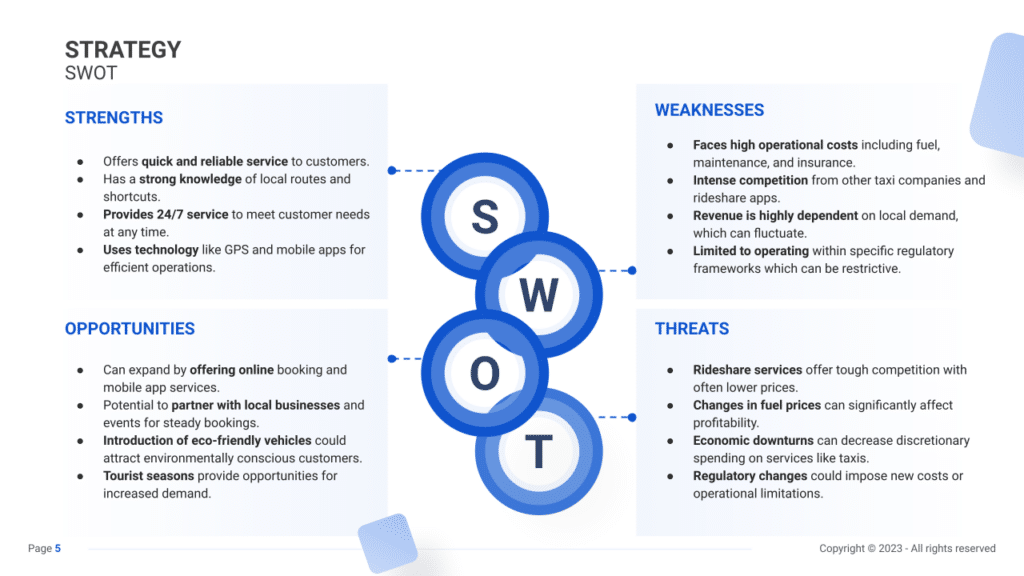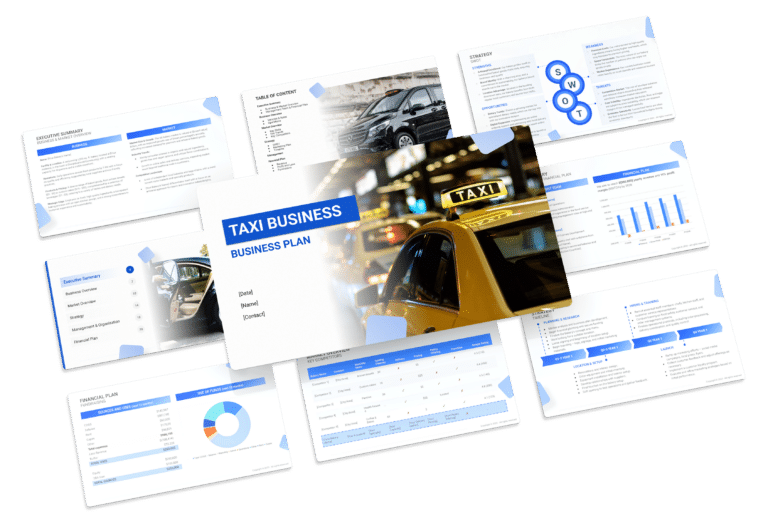SWOT Analysis for a Taxi Service (Example)

A SWOT analysis is crucial for developing a business plan for a taxi service. This analysis, which stands for Strengths, Weaknesses, Opportunities, and Threats, helps understand internal and external factors that can impact your business. Strengths and weaknesses are internal to the business, while opportunities and threats are external.
In this article, we will explore various examples of strengths, weaknesses, opportunities, and threats, aiding taxi service owners in refining strategies and enhancing adaptability in a dynamic industry landscape.

Strengths
Highlight the strengths that set your taxi service apart, ensuring a competitive edge and customer loyalty.
- Diverse Fleet: Offering a varied range of vehicles, including traditional taxis, luxury cars, and eco-friendly options, caters to diverse customer preferences.
- Example: Highlight the diversity of your fleet in marketing materials to attract different customer segments.
- Advanced Technology Integration: Utilizing mobile apps for bookings, GPS navigation, and seamless payment systems enhances customer convenience.
- Example: Emphasize the user-friendly features of the app and secure payment options in marketing campaigns.
- Round-the-Clock Service: Providing 24/7 availability can attract late-night commuters or travelers looking for dependable transportation.
- Example: Promote the round-the-clock availability prominently to highlight convenience for customers at any hour.
- Skilled Drivers and Customer Service: Well-trained drivers and exceptional customer service contribute to customer satisfaction and positive reviews.
- Example: Continuously train drivers in customer interaction and safety protocols to maintain service quality.
Weaknesses
Address weaknesses to fortify your taxi service for sustainable success.
- Dependence on Technology: Relying solely on technology for bookings may pose challenges during system failures or network issues.
- Example: Implement backup systems or manual procedures to handle bookings during technical outages.
- Maintenance Costs for Fleet: High maintenance expenses for a diverse fleet may strain operational budgets.
- Example: Explore partnerships with maintenance services or invest in more fuel-efficient vehicles to reduce long-term maintenance costs.
- Seasonal Demand Fluctuations: Variations in demand during off-peak seasons can lead to revenue inconsistencies.
- Example: Create promotional offers or partnerships during low-demand periods to stimulate business.
- Competition with Ride-Sharing Services: Intense competition from ride-sharing apps might impact market share and pricing competitiveness.
- Example: Focus on personalized service, punctuality, and building customer relationships to differentiate from ride-sharing alternatives.
Opportunities
Seize opportunities to expand and innovate in your taxi service.
- Partnerships for Exclusive Services: Collaborating with hotels, airports, or event venues for exclusive pick-up and drop-off services secures a steady customer base.
- Example: Offer special packages or discounted rates for hotel guests or frequent flyers through partnerships.
- Environmental Sustainability: Responding to the demand for eco-friendly transport by introducing electric or hybrid vehicles attracts environmentally conscious customers.
- Example: Promote eco-friendly aspects of the fleet to appeal to environmentally conscious riders.
- Expansion to Underserved Areas: Expanding service areas to cover underserved regions or suburbs taps into new customer segments.
- Example: Conduct market research to identify areas with high transportation demand and devise strategies to enter these markets.
- Corporate Partnerships for Employee Transport: Forming partnerships with corporations for employee transportation services ensures consistent business.
- Example: Offer tailored packages to companies for their employee transport needs, emphasizing reliability and punctuality.
Threats
Prepare for potential threats to ensure the resilience of your taxi service.
- Regulatory Changes: Evolving regulations and licensing requirements can impact operational costs and service quality.
- Example: Stay updated with local transportation laws and adjust operations accordingly to maintain compliance.
- Emergence of Autonomous Vehicles: Future advancements in self-driving technology might disrupt the traditional taxi industry.
- Example: Explore opportunities in autonomous or semi-autonomous vehicle services to stay ahead in the market.
- Security Concerns: Ensuring passenger safety and reducing risks associated with assaults or thefts during rides.
- Example: Implement safety measures like panic buttons, driver background checks, and real-time monitoring systems for enhanced security.
- Price Wars with Competitors: Price competition with ride-sharing services might lead to lower profitability or compromise service quality.
- Example: Focus on providing value-added services, superior customer experience, or specialized services to justify pricing differences.





